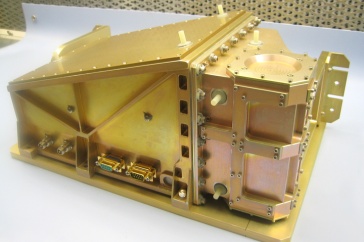UNH Scientists Play Role in NASA Mission to Send Astronauts Safely Back to Moon

The Cosmic Ray Telescope for the Effects of Radiation (CRaTER) was designed and built by UNH’s Space Science Center and has been making crucial radiation measurements while orbiting the moon. Credit: UNH
DURHAM, N.H.—As NASA launches the Orion spacecraft as part of the Artemis 1 mission, the United States will be one step closer to the moon for the first time in 50 years. Scientists at the University of New Hampshire have made an important contribution in determining if radiation levels at the moon, which can cause serious health issues, are safe enough for astronauts.
To measure those levels, researchers at UNH’s Space Science Center built one of the two instruments on NASA’s Lunar Reconnaissance Orbiter (LRO) that has been monitoring space radiation levels. The Cosmic Ray Telescope for the Effects of Radiation (CRaTER), was launched in 2009 and has been making crucial measurements while orbiting the moon ever since.
“Artemis 1 is the next important steppingstone to putting humankind back on the moon,” said Harlan Spence, professor of physics and principal investigator for the CRaTER instrument. “CRaTER has diligently been monitoring radiation so Artemis will not venture into the unknown but rather confidently into a well understood environment with a design and instruments needed to make a safe journey with astronauts.”
The unmanned Artemis 1 mission is expected to liftoff September 3 between 2:17 and 4:17 p.m. ET from Kennedy Space Center in Florida, but the mission team will review data, weather and overall readiness on Thursday, September 1. In place of real astronauts, NASA is flying instrumented mannequins or “moonikins” in the Orion spacecraft that will ultimately shuttle humans on the same trip back to the moon. One of the instruments in those simulated astronauts will also be measuring radiation.
The University of New Hampshire inspires innovation and transforms lives in our state, nation and world. More than 16,000 students from all 50 states and 71 countries engage with an award-winning faculty in top-ranked programs in business, engineering, law, health and human services, liberal arts and the sciences across more than 200 programs of study. A Carnegie Classification R1 institution, UNH partners with NASA, NOAA, NSF and NIH, and received $260 million in competitive external funding in FY21 to further explore and define the frontiers of land, sea and space.
PHOTO FOR DOWNLOAD
Photo: https://crater.unh.edu/graphics/flight_model_lg.jpg
Caption: The Cosmic Ray Telescope for the Effects of Radiation (CRaTER) was designed and built by UNH’s Space Science Center and has been making crucial radiation measurements while orbiting the moon.
Credit: UNH
Latest News
-
November 26, 2025
-
November 6, 2025
-
November 5, 2025
-
October 24, 2025
-
October 8, 2025














































